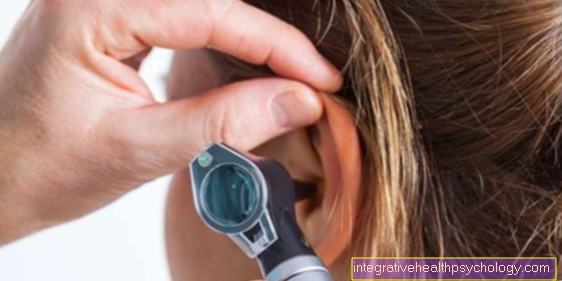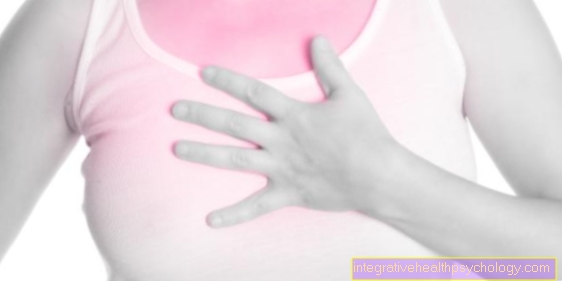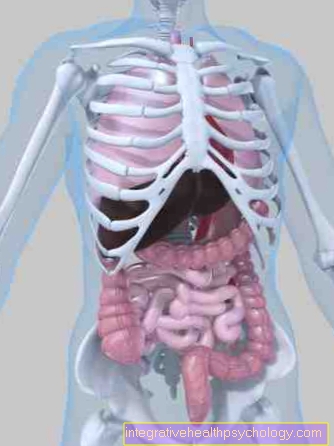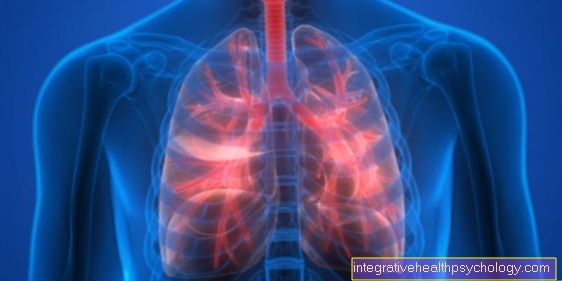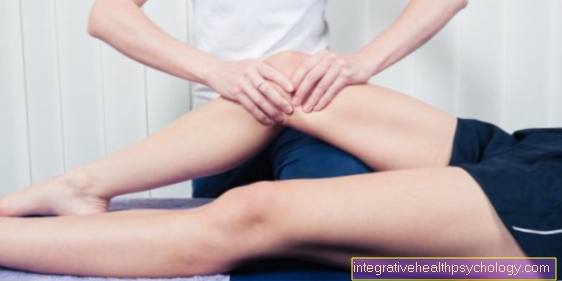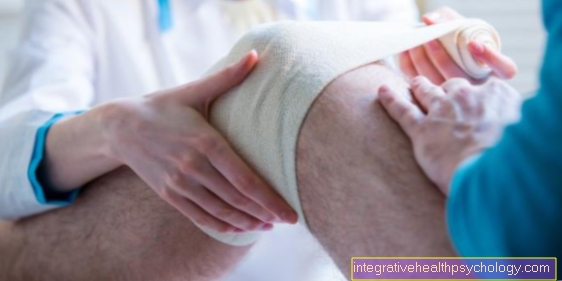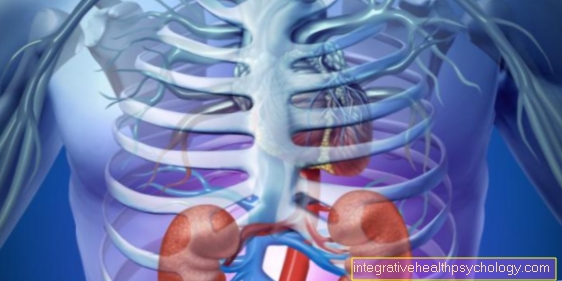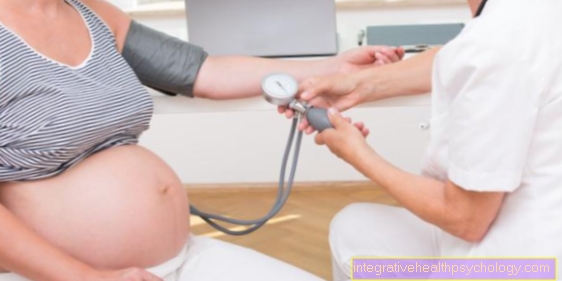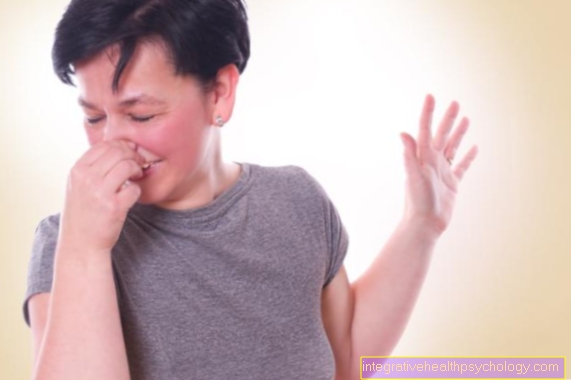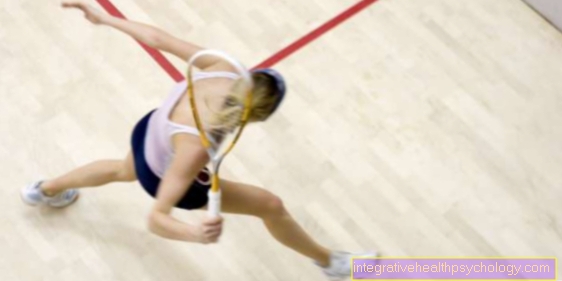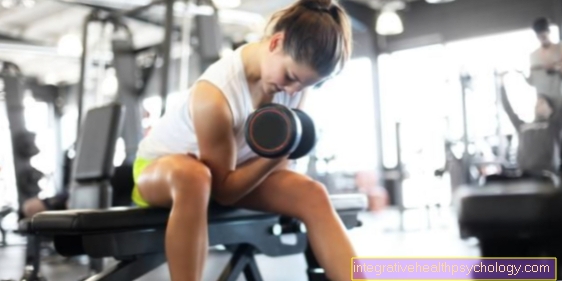Bursitis of the shoulder
introduction
The bursitis in the shoulder (Subacrominal bursitis) is a common phenomenon, particularly among middle-aged people.
The bursa forms a sliding layer for the muscles and also separates them from the bones. Since this bursa is strained with almost every movement in the shoulder, it is also particularly prone to pain.
Due to its clinical picture, bursitis in the shoulder is relatively easy to distinguish from other causes of pain in the shoulder.

However, there are many causes of bursitis, for which it is important to treat it at an early stage so that the inflammation does not become chronic. Bursitis is so painful because the bursa acts as a layer between muscles and bones. If the bursa can no longer perform this task due to inflammation, severe pain occurs.
Symptoms of bursitis
First of all, there is severe pain in the shoulder. The so-called “painful arch” is particularly noticeable. The patients feel the greatest pain until they have lifted the arm over 90 °, after which they can continue to lift the arm without feeling any further pain.
In the case of bursitis in the shoulder, there are also the typical local signs of inflammation such as redness and, in addition to pain, swelling. These general signs of inflammation are unspecific and may be due to other inflammation.
The pain in particular is to be understood as a warning signal to which the load on the shoulder should be stopped immediately to avoid major damage. If the inflammation persists, there is an increased build-up of fluid and collagen. Due to the excessive production of collagen, chronic inflammation of the bursa can also lead to a stiffening of the joint, which is, however, rather rare, since the bursitis in the shoulder is usually detected early. On the other hand, the movement pattern listed above is very clear, and is also leading the way in diagnostics.
Another symptom is the restriction of movement, which is mainly caused by the pain. If the bursitis remains untreated for a long time, it can lead to atrophy of the shoulder muscles in the long run due to the relieving posture adopted. However, it takes a long time until these symptoms occur. Most of the time, the impairment caused by the pain is so great that those affected get help before the muscles decrease.
In order to be able to differentiate a bursitis from a capsule tear in the shoulder area, it is recommended to deal with the following topic: Capsule tear in the shoulder
Nocturnal pain as a symptom
As a rule, the pain does not occur at rest, but only through slight movements and external pressure. When sleeping, however, even small movements or lying on your side can lead to sharp pain and severely impair night sleep.
In these cases, pain relievers such as ibuprofen or diclofenac can be taken for a short time. These reduce the pain and enable a good night's sleep, which can also contribute significantly to the healing of the inflammation.
Appointment with a shoulder specialist

I would be happy to advise you!
Who am I?
My name is Carmen Heinz. I am a specialist in orthopedics and trauma surgery in the specialist team of .
The shoulder joint is one of the most complicated joints in the human body.
The treatment of the shoulder (rotator cuff, impingement syndrome, calcified shoulder (tendinosis calcarea, biceps tendon, etc.) therefore requires a lot of experience.
I treat a wide variety of shoulder diseases in a conservative way.
The aim of any therapy is treatment with full recovery without surgery.
Which therapy achieves the best results in the long term can only be determined after looking at all of the information (Examination, X-ray, ultrasound, MRI, etc.) be assessed.
You can find me in:
- - your orthopedic surgeon
14
Directly to the online appointment arrangement
Unfortunately, it is currently only possible to make an appointment with private health insurers. I hope for your understanding!
You can find more information about myself at Carmen Heinz.
The loss of strength as a symptom
The inflammation in the shoulder joint can lead to temporary but also permanent loss of strength. The shoulder bursa serves primarily to shield the tendon of the supraspinatus muscle from the bone and to enable its movement under the so-called "acromion", part of the roof of the shoulder.
If there is inflammation, the supraspinatus tendon can be irritated and injured. Raising the arm to the side, known as “abduction”, becomes painful and impossible at an early stage. It usually represents the first muscular limitation in a bursitis of the shoulder. If the inflammation is left untreated, it can lead to long-term complications of stiff shoulder and a decline in the shoulder muscles. Here, too, long-term power losses are to be expected.
For this reason, physiotherapy is recommended at the earliest possible point in time in order to maintain and strengthen existing movements.
Frozen shoulder as a symptom
In some cases, the very unpleasant symptom of the frozen shoulder can occur. As the English term suggests, there is a stiffness of the shoulder joint. This is due to the inflammation of the joint or the bursa of the shoulder, which results in sticking. The affected person can neither move the shoulder himself nor let it move passively.
The rotation in the shoulder and abduction, i.e. the lateral lifting of the upper arm, are particularly affected. At first there is only severe pain in the joint. The frozen shoulder develops later, and the pain subsides.
If no improvement is possible with the administration of painkillers and slight passive movement, the joint can be vigorously moved under a brief anesthetic in order to loosen the adhesions. In the worst case, the joint capsule must be surgically split.
More information on the topic Frozen shoulder get here.
Shoulder blade pain
The shoulder blade is closely anatomically related to the bursa of the shoulder joint. The shoulder blade has protruding bones that represent an important muscle attachment point and part of the shoulder joint. The shoulder roof is also formed by parts of the shoulder blade. The so-called "acromion", also part of the shoulder blade, runs above the bursa.
For various reasons, such as irritation, incorrect loading or inflammation, structures under the Acromion get pinched and cause pain. The most common change in this area is the "impingement syndrome", which is clinically very similar to bursitis of the shoulder. In many cases, this pain can project itself over the roof of the shoulder onto the shoulder blade.
Read more about the topic here: Impingement Syndrome
The bursitis in combination with a calcified shoulder
The calcareous shoulder is an independent clinical picture, which, however, is often associated with bursitis of the shoulder. Both diseases can result from excessive strain, accidents, pressure and tensile loads, but also metabolic and circulatory disorders.
The formation of the calcareous shoulder begins with a transformation of the tendons of the shoulder into cartilage tissue, due to the reduced blood flow. Lime is then stored in these structures. These limescale foci are often in the area below the roof of the shoulder, where they can in turn press on the bursa. This in turn can cause bursitis. The remaining muscles of the shoulder can also become inflamed and damaged.
In most cases, the lime shoulder does not need to be treated because the inflammation will subside by itself and the lime will break down again.
Find out more about the topic here: Lime shoulder.
The diagnosis
The diagnosis is usually based on the clinical symptoms of the painful arch. Diagnostics can also be supported by an X-ray image, but ultrasound can also be used due to the radiation exposure during X-rays.
Another imaging examination here is magnetic resonance imaging of the shoulder (MRI of the shoulder). In this examination, soft tissue swellings and effusions in the shoulder joint can be shown well. However, the shoulder MRI is rarely used in the case of bursitis of the shoulder, as the examination takes a relatively long time and the examination of the movement and pain pattern is usually clear. Since effusions can also be detected with the ultrasound device and this device is available in many general practitioners' practices, this is a good alternative to the very complex MRI.
There are also several function tests that are carried out if a bursitis of the shoulder is suspected. When examining for the so-called Neer's sign, the patient is asked to keep his arm outstretched in the starting position while the examiner fixes the shoulder blade. The patient is then asked to raise his arm; pain when lifting the arm indicates an impingement syndrome. This is called a positive Neer sign.
What do you see in the MRI?
Bursitis is a diagnosis that, in most cases, is based on symptoms and physical examination. Other procedures such as MRT are rarely used because they are expensive and complex.
In the MRI, however, changes such as inflammation, soft tissue swelling, effusions and muscle degeneration can be seen very well. The MRI is particularly suitable for assessing soft tissue. In the case of bursitis, swelling and inflammation of the bursae and the surrounding muscles can accordingly often be found. Also, effusions from the inflammation in the joint can often be seen in the MRI. However, these can also be detected in the ultrasound examination, so that an MRI examination is not necessary in most cases.
More information is available here: MRI of the shoulder joint.
What do you see in the ultrasound?
The ultrasound examination often comes first after the anamnesis and the physical examination, as it is an inexpensive, simple and quick examination.
Similar to MRI, swellings, clear swellings, inflammation and effusions in the shoulder joint can be detected in the ultrasound. However, the image sharpness allows only limited statements about the extent of the disease, but can corroborate an existing suspicion.
Which doctor treats shoulder bursitis?
Bursitis of the shoulder is basically an orthopedic problem. In the acute situation, the orthopedic surgeon can initiate initial measures in the form of immobilization, rest, tape bandages, cortisone injections and other treatments.
Even a family doctor can often identify and treat incipient bursitis with the help of a physical examination and an ultrasound device.
Unclear findings rarely need to be clarified radiologically. An appointment with the radiologist is necessary for the diagnosis.
causes
There are several causes of shoulder bursitis. On the one hand, small microtraumas can repeatedly occur in the bursa, which means that bacteria can repeatedly invade the bursa and trigger inflammation there. The damaged bursa reacts to this with increased collagen and fluid production, which in turn leads to further functional restrictions.
On the other hand, impingement syndrome can trigger bursitis. This results in an entrapment of the tendon of the Supraspinatus musclewhich in this way leads to irritation of the bursa directly next to it. The supraspinatus muscle is responsible, among other things, for the external rotation of the arm.
It can also lead to microcalcification deposits in the bursa in the shoulder joint, as a result of which new inflammations develop again and again. These microcalcification deposits are normal signs of age, but they are more likely to lead to the development of bursitis in some people than in others. In addition, the formation of these deposits is triggered by inflammation, so that the risk of further bursitis increases with each inflammation. In the context of chronic joint diseases, bursitis of the shoulder can also occur more frequently.
Chronic joint diseases can be rheumatoid arthritis or gout, for example. These diseases lead to changes in the joint, which is why the bursa can no longer optimally fulfill its function as a sliding layer. The permanent irritation caused by attachments and modifications to the joint then leads to inflammation of the bursa in the shoulder. For the same reason, osteoarthritis of the shoulder joint can also lead to more frequent bursitis.
The therapy options
The first therapeutic measure is to immobilize the shoulder joint, since this way the bursa is not put under any more stress. Immobilization usually also leads to a decrease in pain, as the bursitis of the shoulder is particularly painful when movements are exerted on the bursa. Cooling the bursa can also help to relieve pain.
Pain therapy is important in the therapy of bursitis in the shoulder so that no pathological movement patterns are learned. Therefore, the generous use of pain killers is justified. So-called non-steroidal anti-inflammatory drugs (NSAIDs) are often used for this. This group of pain relievers includes aspirin, which is the enzyme Cyclooxygenase affects, as well as ibuprofen. When taking aspirin, however, one should make sure to use suitable gastric protection, as this drug also inhibits the production of gastric mucus, which neutralizes stomach acid. Therefore, continuous use of aspirin can lead to stomach upsets. The NSAIDs inhibit the production of inflammatory mediators, which is why there is a decrease in inflammation.
Another therapeutic approach is physiotherapy. This can also be used in addition to drug therapy. In physiotherapy, gentle movement patterns are learned and it should also be shown how those affected can avoid movements in the future that favor the development of bursitis of the shoulder.
Another option is to inject cortisone and its derivatives directly into the affected bursa. These so-called steroids also reduce the release of inflammatory mediators like NSAIDs. The focus is also on reducing the inflammation of the shoulder bursa. However, the steroid derivatives are derivatives of the body's own substances, which is fundamentally different from the NSAIDs.
Another therapy option is an operation. The bursa is removed in a minimally invasive manner. However, you should only take this step if other therapeutic approaches have not shown success. Although the operation is free of symptoms, like any other operation it naturally also involves risks. For example, wound healing disorders or infections of the surgical wound can occur after the operation.
The cortisone injection
After unsuccessful therapy through immobilization and rest, many orthopedic surgeons use cortisone injections in the shoulder. In the case of severe symptoms, a cortisone injection can be an important alternative therapy. Cortisone is an endogenous hormone which, in therapeutic doses, has an anti-inflammatory effect.This has a positive effect on bursitis. This can subside and sometimes even heal. Nevertheless, the cortisone injection is a symptomatic therapy. If the triggers that led to the bursitis are left untreated, the inflammation can return.
Nowadays, the cortisone injection is increasingly being replaced by many other, sometimes more sustainable, treatment options. In acute cases, however, it is an important method to keep the inflammation in check.
Find out more about the topic here Cortisone syringe and its areas of application.
Radiotherapy
Radiation therapy is also a potential alternative therapy for bursitis of the shoulder. It should be considered as a less invasive method, especially before surgery in the case of ineffective previous therapies or recurring inflammations.
The doses of the radiation in this treatment are significantly lower than, for example, in the therapy of a malignant tumor disease. Due to the low dosage of the rays, extensive tissue damage is not to be expected, but rather a scientifically proven anti-inflammatory effect.
More than half of those treated describe at least some alleviation of the symptoms after radiation.
The osteopathy
Osteopathy represents an alternative medical direction that assumes a different origin for diseases of the musculoskeletal system. According to this, all body regions are closely related to one another and complaints arise when imbalances or movement disorders arise in one area of the body.
Osteopathy is primarily responsible for the development of bursitis of the shoulder due to increased tensile and pressure loads, as well as tension in the connective tissue fascia of the shoulder. The tense fasciae narrow the anatomical structures and lead to long-term degeneration and discomfort. Osteopathic therapy tries to loosen and relax the fascia by means of manual interventions and movements. The effect of osteopathy is largely unproven and controversial.
Find out more about the topic here: Osteopathy.
The kinesio tape
So-called "kinesio tapes" are used today for therapy and prevention not only in orthopedic diseases, but also in numerous other specialist areas. These are elastic tape dressings that are stuck to the skin with certain techniques under tension.
In the treatment of bursitis of the shoulder, kinesio tapes can support joint function as well as relieve and relax the muscles. In addition, the tape on the skin is supposed to improve blood circulation, lymphatic drainage and muscle circulation, thereby positively influencing inflammation and providing pain relief.
The effects of the kinesio tape are controversial and not scientifically proven. In sports medicine, the tapes are mainly used in prevention. In the case of previous complaints, the tapes can also be stuck on the shoulder to prevent pain.
Read more about the topic here: Kinesio tape.
Homeopathy
Homeopathy is an alternative medicine, drug treatment. Here, active ingredients are only used in such a diluted manner that they can no longer be detected chemically. The preparations are intended to stimulate the healing of the disease by conveying information.
Homeopathic preparations can be used to support both acute and chronic complaints in order to stimulate the body's self-healing powers. The exact choice of the preparation should be determined by a homeopath. Frequently used remedies for inflammation are Silicea terra, the silicic acid or Sticta pulmonaria.
Acupuncture
The principle of acupuncture in the treatment of bursitis of the shoulder consists in irritating certain points of the skin, so-called "meridians", which should lead to self-regulation of the body and activation of the self-healing powers. For this purpose, small needles are stuck into the skin at certain, previously determined sensitive points, which may stimulate the release of endogenous hormones and the healing of acute complaints. There is acupuncture of the whole body or ear acupuncture.
The processes that are set in motion by the stimulation of the needles are intended to serve both as causal therapy and to alleviate pain symptoms. The extent of the effect and the exact mode of action of acupuncture are not known and are controversial.
Find out more about the topic here Acupuncture.
Warmth or cold in case of bursitis
Heat and cold can both have positive and negative effects on inflammation. It is important to use them at the right time.
Cold helps especially in acute situations. It reduces blood flow and metabolism, which is why acute inflammation, swelling and bleeding caused by the cold can be prevented. As a rule, it is assumed that cold has positive effects within the first 48 hours after an acute event.
After that, in the healing phase, warmth is more advisable. The heat promotes blood circulation and can help the body fight the inflammation on its own. The muscles are also relaxed and supplied with blood by the warmth, allowing them to regenerate slowly.
Which home remedies help with bursitis?
The average bursitis often does not require any drug or surgical therapy at all. In addition to protection, conventional home remedies in particular can help relieve symptoms and, in some cases, also reduce inflammation. In addition to protection, cooling is an option in the acute phase. If the inflammation has persisted, warming the area can help.
Herbal remedies such as ginger, castor oil or vinegar can help relieve pain and reduce inflammation in different ways.
Read more about the topic here: Which home remedies help with bursitis of the shoulder?
Treatment of bursitis with cottage cheese
Quark wraps can be used as a supportive measure. Above all, they help with irritation and slight inflammation of the bursa as a supportive home remedy when medication does not seem necessary. Quark compresses can relieve pain through various mechanisms and have a positive effect on inflammation.
On the one hand, quark cools the skin directly, which inhibits inflammatory activity and reduces pain sensitivity. The cooling effect can also reduce swelling and effusions and reduce tissue damage in the acute phase. In addition, the ingredients of the quark should stimulate the metabolism in the body and also have anti-inflammatory effects. In order for the quark compresses to last, they must be renewed every 15 minutes.
Which exercises can help?
In the treatment of bursitis of the shoulder, both simple exercises and manual therapy can relieve and prevent pain. The exercises should never be done too early, as irritation and inflammation may worsen. Physiotherapy promotes the development of the shoulder muscles and corrects bad posture / incorrect movements.
An example exercise would be to wedge a teraband in the top of the closed door at home. Then stand sideways to the door and stretch the tape with your arm straight until you touch your hips. This strengthens the adductor muscles, which has a positive effect on the tightness under the shoulder roof.
Furthermore, while sitting at the desk, you can wipe a small towel away from you with one arm and repeat this movement. This mobilizes the arm somewhat from the shoulder joint, which can alleviate complaints such as the frozen shoulder.
Finally, you can hold a teraband with your elbows and forearms stretched out in both hands. Then rotate both arms away from the body while pulling against the tera ligament while keeping your elbows in place. Here, too, the tightness in the shoulder joint, which leads to problems such as bursitis, is loosened.
Duration of bursitis
The duration of the bursitis is very dependent on the extent of the damage in the tissue and the time of diagnosis and treatment. The most important treatment basis is the earliest possible intervention. If an immediate sports and exercise abstinence is observed when the pain is only slight, the slight inflammation can heal within about 2 weeks. The pain can subside after just a few days of rest.
Severe pain and inflammation can be associated with a long duration of illness and an uncertain prognosis. Sometimes the inflammation can be so severe and persistent that it is unlikely to heal by itself. Conservative treatments can be unsuccessful for months, making surgery necessary.
Length of incapacity for work
The duration of the inability to work depends on the extent and prognosis of the individual illness but also on the type of occupation.
Early and adequate protection of the shoulder is part of optimal therapy. For this reason, incapacity for work should be generously issued in the event of mild, onset pain. Otherwise, severe inflammation without therapeutic success can lead to months of failure. Depending on the occupation, long-term inability to work can even arise. Heavy physical work that includes lifting may no longer be possible. Office work, on the other hand, can be resumed shortly after pain relief, provided there is no strain on the shoulder.
forecast
The prognosis for bursitis of the shoulder treated early is quite good. It is important that the bursitis is treated early. Early treatment increases the good prognosis, as no attempt is made to learn pathological movement patterns to avoid pain.
The further the inflammation progresses if left untreated, the higher the risk of complications. Fortunately, with adequate treatment, complications are rare. Complications with this type of disease can be, for example, stiffening of the joint or a decline in the shoulder muscles. However, this decrease in the muscles only occurs after a longer period of immobilization.
With recurrent bursitis of the shoulder, the long-term prognoses are a little different. Although the individual inflammations can always be brought under control with drug therapy, drug therapy can in the long run trigger side effects. Therefore, in consultation with their doctor, those affected can consider an operation to remove the bursa. However, this step should only be considered if the pain persists.
Movement training, in which patients learn to avoid particularly stressful movements, also has an improving effect. In the case of chronic bursitis of the shoulder as a side effect of another chronic disease such as rheumatoid arthritis, the prognosis depends very much on the course of the underlying chronic disease. Here, too, the pain can be treated, but the basic problem of a permanently irritated bursa persists in the long run.
prophylaxis
As a prophylaxis of a chronification of the bursitis of the shoulder, an early therapy offers itself. However, if you have already healed bursitis of the shoulder and want to avoid another one, you should choose the appropriate and joint-friendly sport. For example, regular swimming training is very suitable for doing sports that are gentle on all joints. You should refrain from engaging in sports that exert large shear forces on the shoulder. Wrestling is one of these sports. You should also get used to climbing slowly after surviving bursitis of the shoulder. However, it is also true that you should not stop exercising completely because you have overcome bursitis. You should only initially avoid excessive force on the shoulder.
Since bursitis of the shoulder usually occurs on the arm that is more heavily loaded, an attempt should be made in the future to apply approximately the same amount of weight to both arms. This is mostly noticeable during simple activities such as lifting and carrying a suitcase. Especially after a bursitis one should try to lift heavy objects with the other arm and not apply strong mechanical stimuli to the bursa. In general, moderate training of the muscles protects against bursitis, but care should be taken that weight training is not carried out too excessively, as this can have the opposite effect. If you notice pain in the shoulder, it is advisable to clarify the causes directly before the shoulder joint is further stressed.

